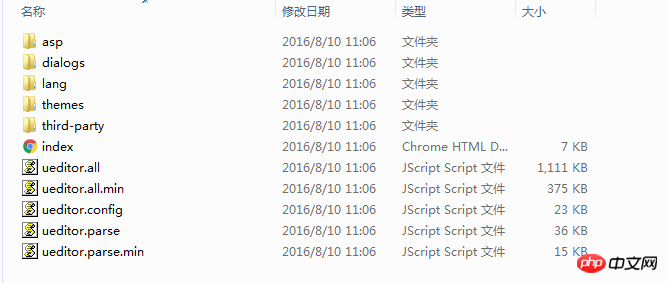Vue.js结合Ueditor富文本编辑器的使用方法
本篇文章主要介绍了Vue.js结合Ueditor的项目实例代码,这里整理了详细的代码,具有一定的参考价值,有兴趣的可以了解一下
在前端开发的项目中。难免会遇到需要在页面上集成一个富文本编辑器。
前一段时间公司Vue.js项目需要使用UEditor富文本编辑器,在百度上搜索一圈没有发现详细的说明,决定自己尝试,忙活了一天终于搞定了。
1. 总体思路
1.1 模块化
vue的很大的一个优势在于模块化,我们可以通过模块化实现页面和逻辑的复用。所以可以把Ueditor重新封装成一个.vue的模板文件。其他组件通过引入这个模板实现代码复用。
1.2 数据传输
首先父组件需要设置编辑器的长度、宽度、初始文本,这些数据可以通过props来传递。编辑器中的文本变化可以通过vue自定义事件向父组件传递。
2. 具体实现步骤
2.1 引入关键的JS以及CSS文件
将以下文件全部拷贝到项目中

2.2 配置Ueditor.config.js
首先配置URL参数,我们需要将这个路径指向刚才拷贝的文件的更目录,注意这里最好使用相对路劲。
var URL = window.UEDITOR_HOME_URL || '/static/ueditor/';
然后是默认宽度高度的设置
,initialFrameWidth:null // null表示宽度自动 ,initialFrameHeight:320
其他功能的配置可以在官方文档查看
2.3 创建编辑器模板
我们需要在编辑器模板中import Ueditor核心JS库,并添加contentChange回调函数就大功告成了。
之所以使用import语法来引入核心JS库是因为这样更符合ES6模块化的规范,我看到网上有人建议在main.js中引入JS,但是过早地引入JS可能导致页面首次加载缓慢。
<template>
<p ref="editor"></p>
</template>
<script>
/* eslint-disable */
import '../../../assets/js/ueditor/ueditor.config';
import '../../../assets/js/ueditor/ueditor.all';
import '../../../assets/js/ueditor/lang/zh-cn/zh-cn';
import { generateRandonInteger } from '../../../vuex/utils';
export default {
data() {
return {
id: generateRandonInteger(100000) + 'ueditorId',
};
},
props: {
value: {
type: String,
default: null,
},
config: {
type: Object,
default: {},
}
},
watch: {
value: function value(val, oldVal) {
this.editor = UE.getEditor(this.id, this.config);
if (val !== null) {
this.editor.setContent(val);
}
},
},
mounted() {
this.$nextTick(function f1() {
// 保证 this.$el 已经插入文档
this.$refs.editor.id = this.id;
this.editor = UE.getEditor(this.id, this.config);
this.editor.ready(function f2() {
this.editor.setContent(this.value);
this.editor.addListener("contentChange", function () {
const wordCount = this.editor.getContentLength(true);
const content = this.editor.getContent();
const plainTxt = this.editor.getPlainTxt();
this.$emit('input', { wordCount: wordCount, content: content, plainTxt: plainTxt });
}.bind(this));
this.$emit('ready', this.editor);
}.bind(this));
});
},
};
</script>
<style>
body{
background-color:#ff0000;
}
</style>3. 编辑器的使用
使用编辑器模板的时候我需要通过props传入config以及初始文本value。
<template xmlns:v-on="http://www.w3.org/1999/xhtml">
<p class="edit-area">
<ueditor v-bind:value=defaultMsg v-bind:config=config v-on:input="input" v-on:ready="ready"></ueditor>
</p>
</template>
<script>
import ueditor from './ueditor.vue';
export default {
components: {
ueditor,
},
data() {
return {
defaultMsg: '初始文本',
config: {
initialFrameWidth: null,
initialFrameHeight: 320,
},
};
},
};
</script>如果需要让Ueditor上传图片的话,还需要在后台配置一个接口。这部分还没有时间研究,等过几天补上
以上就是本文的全部内容,希望对大家的学习有所帮助,更多相关内容请关注PHP中文网!
相关推荐:
以上是Vue.js结合Ueditor富文本编辑器的使用方法的详细内容。更多信息请关注PHP中文网其他相关文章!

热AI工具

Undresser.AI Undress
人工智能驱动的应用程序,用于创建逼真的裸体照片

AI Clothes Remover
用于从照片中去除衣服的在线人工智能工具。

Undress AI Tool
免费脱衣服图片

Clothoff.io
AI脱衣机

AI Hentai Generator
免费生成ai无尽的。

热门文章

热工具

记事本++7.3.1
好用且免费的代码编辑器

SublimeText3汉化版
中文版,非常好用

禅工作室 13.0.1
功能强大的PHP集成开发环境

Dreamweaver CS6
视觉化网页开发工具

SublimeText3 Mac版
神级代码编辑软件(SublimeText3)
 vue中组件化和模块化有什么区别
Dec 15, 2022 pm 12:54 PM
vue中组件化和模块化有什么区别
Dec 15, 2022 pm 12:54 PM
组件化和模块化的区别:模块化是从代码逻辑的角度进行划分的;方便代码分层开发,保证每个每个功能模块的职能一致。组件化是从UI界面的角度进行规划;前端的组件化,方便UI组件的重用。
 深入探讨vite是怎么解析.env文件的
Jan 24, 2023 am 05:30 AM
深入探讨vite是怎么解析.env文件的
Jan 24, 2023 am 05:30 AM
使用vue框架开发前端项目时,我们部署的时候都会部署多套环境,往往开发、测试以及线上环境调用的接口域名都是不一样的。如何能做到区分呢?那就是使用环境变量和模式。
 实战:vscode中开发一个支持vue文件跳转到定义的插件
Nov 16, 2022 pm 08:43 PM
实战:vscode中开发一个支持vue文件跳转到定义的插件
Nov 16, 2022 pm 08:43 PM
vscode自身是支持vue文件组件跳转到定义的,但是支持的力度是非常弱的。我们在vue-cli的配置的下,可以写很多灵活的用法,这样可以提升我们的生产效率。但是正是这些灵活的写法,导致了vscode自身提供的功能无法支持跳转到文件定义。为了兼容这些灵活的写法,提高工作效率,所以写了一个vscode支持vue文件跳转到定义的插件。
 图文详解如何在Vue项目中集成Ace代码编辑器
Apr 24, 2023 am 10:52 AM
图文详解如何在Vue项目中集成Ace代码编辑器
Apr 24, 2023 am 10:52 AM
Ace 是一个用 JavaScript 编写的可嵌入代码编辑器。它与 Sublime、Vim 和 TextMate 等原生编辑器的功能和性能相匹配。它可以很容易地嵌入到任何网页和 JavaScript 应用程序中。Ace 被维护为Cloud9 IDE的主要编辑器 ,并且是 Mozilla Skywriter (Bespin) 项目的继承者。
 深入聊聊vue3中的reactive()
Jan 06, 2023 pm 09:21 PM
深入聊聊vue3中的reactive()
Jan 06, 2023 pm 09:21 PM
前言:在vue3的开发中,reactive是提供实现响应式数据的方法。日常开发这个是使用频率很高的api。这篇文章笔者就来探索其内部运行机制。
 探讨如何在Vue3中编写单元测试
Apr 25, 2023 pm 07:41 PM
探讨如何在Vue3中编写单元测试
Apr 25, 2023 pm 07:41 PM
当今前端开发中,Vue.js 已经成为了一个非常流行的框架。随着 Vue.js 的不断发展,单元测试变得越来越重要。今天,我们将探讨如何在 Vue.js 3 中编写单元测试,并提供一些最佳实践和常见的问题及解决方案。
 解析Vue2实现composition API的原理
Jan 13, 2023 am 08:30 AM
解析Vue2实现composition API的原理
Jan 13, 2023 am 08:30 AM
自从 Vue3 发布之后,composition API 这个词走入写 Vue 同学的视野之中,相信大家也一直听到 composition API 比之前的 options API 有多好多强,如今由于 @vue/composition-api 插件的发布,Vue2 的同学也可以上车咯,接下来我们主要以响应式的 ref 和 reactive 来深入分析一下,这个插件是怎么实现此







